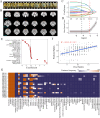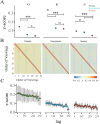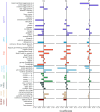Mixed Selectivity Coding of Content-Temporal Detail by Dorsomedial Posterior Parietal Neurons
- PMID: 37985178
- PMCID: PMC10860630
- DOI: 10.1523/JNEUROSCI.1677-23.2023
Mixed Selectivity Coding of Content-Temporal Detail by Dorsomedial Posterior Parietal Neurons
Abstract
The dorsomedial posterior parietal cortex (dmPPC) is part of a higher-cognition network implicated in elaborate processes underpinning memory formation, recollection, episode reconstruction, and temporal information processing. Neural coding for complex episodic processing is however under-documented. Here, we recorded extracellular neural activities from three male rhesus macaques (Macaca mulatta) and revealed a set of neural codes of "neuroethogram" in the primate parietal cortex. Analyzing neural responses in macaque dmPPC to naturalistic videos, we discovered several groups of neurons that are sensitive to different categories of ethogram items, low-level sensory features, and saccadic eye movement. We also discovered that the processing of category and feature information by these neurons is sustained by the accumulation of temporal information over a long timescale of up to 30 s, corroborating its reported long temporal receptive windows. We performed an additional behavioral experiment with additional two male rhesus macaques and found that saccade-related activities could not account for the mixed neuronal responses elicited by the video stimuli. We further observed monkeys' scan paths and gaze consistency are modulated by video content. Taken altogether, these neural findings explain how dmPPC weaves fabrics of ongoing experiences together in real time. The high dimensionality of neural representations should motivate us to shift the focus of attention from pure selectivity neurons to mixed selectivity neurons, especially in increasingly complex naturalistic task designs.
Keywords: dorsomedial posterior parietal cortex; information accumulation; mixed selective representation; neuroethology; scan path and gaze consistency; temporal receptive window.
Copyright © 2024 the authors.
Figures










Similar articles
-
Visual, presaccadic, and cognitive activation of single neurons in monkey lateral intraparietal area.J Neurophysiol. 1996 Nov;76(5):2841-52. doi: 10.1152/jn.1996.76.5.2841. J Neurophysiol. 1996. PMID: 8930237
-
Matching patterns of activity in primate prefrontal area 8a and parietal area 7ip neurons during a spatial working memory task.J Neurophysiol. 1998 Jun;79(6):2919-40. doi: 10.1152/jn.1998.79.6.2919. J Neurophysiol. 1998. PMID: 9636098
-
Motor intention activity in the macaque's lateral intraparietal area. I. Dissociation of motor plan from sensory memory.J Neurophysiol. 1996 Sep;76(3):1439-56. doi: 10.1152/jn.1996.76.3.1439. J Neurophysiol. 1996. PMID: 8890265
-
Organizing space through saccades and fixations between primate posterior parietal cortex and hippocampus.Nat Commun. 2024 Dec 1;15(1):10448. doi: 10.1038/s41467-024-54736-7. Nat Commun. 2024. PMID: 39617769 Free PMC article.
-
The role of the parietal cortex in the neural processing of saccadic eye movements.Adv Neurol. 2003;93:141-57. Adv Neurol. 2003. PMID: 12894406 Review.
Cited by
-
The big mixup: Neural representation during natural modes of primate visual behavior.Curr Opin Neurobiol. 2024 Oct;88:102913. doi: 10.1016/j.conb.2024.102913. Epub 2024 Aug 29. Curr Opin Neurobiol. 2024. PMID: 39214044 Review.
References
-
- Adams G (2014) Tinbergen alpha. Release 1. 10.5281/zenodo.13009. http://zenodo.org/record/13009#.VNj3Ji7w-7A - DOI
Publication types
MeSH terms
LinkOut - more resources
Full Text Sources
